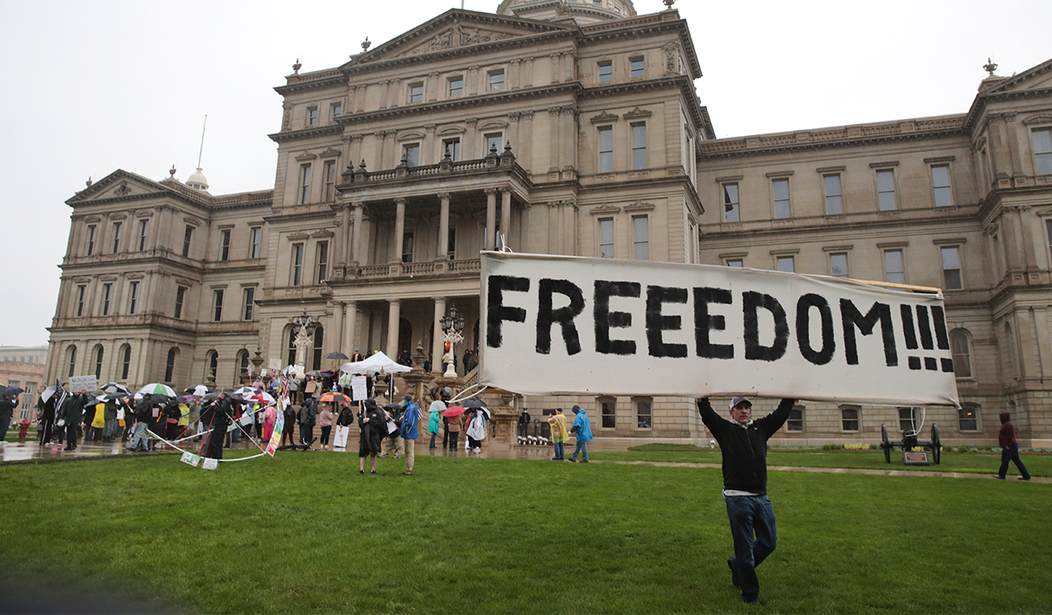Any media discussion of coronavirus deaths typically centers on the ‘official’ raw number, which currently stands at over 90,000. Granted, there are questions about this number, particularly given the fact that someone who dies of a heart attack and has COVID-19 at the time is automatically included in the ever-increasing COVID-count. Would the heart attack victim have survived another day, or another week, had coronavirus not also been present? Maybe, and so apparently goes the rationale for including them in the count. The other, slightly more conspiratorial rationale is that our overlords have a vested interest in ticking the coronavirus death count as high as possible to justify the drastic actions they’ve taken so far and will continue to take, from massive, debt-blowing spending bills to ridiculous lockdowns and draconian attacks on our freedoms. Still, a raw number exists, is constantly increasing (albeit at a slower rate), and is the only thing we hear about when talking heads discuss the toll the virus has taken.
As things creep ever so slowly back to some sort of pre-pandemic “normal,” you’ve doubtless noticed how the goalposts have shifted from “flatten the curve” to “no new cases or deaths” as a baseline for ending the lockdowns and returning to some sense of pre-pandemic “normal.” You’ve probably also noticed how those pretending to care about “every life,” or at least every life affected by COVID-19, are the same people who couldn’t care less about lives in their mother’s wombs, or pretty much anywhere else for that matter. We must lock down everything until the virus goes away forever, say the political left, or someone’s 92-year-old grandmother could DIE. But abortion, of course, is “life-sustaining,” or something.
In reality, there are other reasons why leftists want the lockdowns to continue, but let’s pretend they really believe what they say. Absent their hypocritical abortion stance their rhetoric may sound caring, persuasive even, but is it even a real argument? Nobody with a soul wants anybody’s parents or grandparents to die, but when New York Gov. Andrew Cuomo implies that any measure, no matter how draconian, is justified if it saves a single, solitary life, is he making a serious case?
The great Mike Rowe doesn’t think so, and even blasted Cuomo by name for it during a Fox News appearance the other day: “Well, not to pile up on the governor, but a couple of weeks ago he said another thing that really snapped my neck. He said, ‘No measure no matter how drastic or draconian should be deemed unjustified if it saves a single life.' Safety obviously is very, very, very important, but the notion that nothing in the country is more important than staying safe, that’s not something commonsensical people embrace. That’s something you hear from people who are trying to sell you something, or politicians who are trying to get reelected.”
Recommended
He's right, obviously. By any moral standard everyone’s life matters, and everyone’s life is (or should be) equally protected under the law. But we can’t make any sort of sound public policy that literally ensures that everyone is 100 percent safe from every possible danger. Not only is such a goal impossible, policies that try to achieve it can’t help but place some people’s lives over others. Were society to, for example, make the decision to restrict speed limits to 5 mph in order to “save” the lives of the tens of thousands who die from traffic accidents every year, how many others would suffer and even die from just the massive supply chain interruptions such a policy would cause?
Risk has, is, and will always be a part of everything mortal humans do in life. And as it turns out, thankfully, the risk of dying from coronavirus really isn’t all that high, despite the hysterical media hype surrounding it. Already, we’re seeing numbers that show the average coronavirus age of death to be higher than the average human age of death. The vast, vast majority of people who die from coronavirus are either very old and/or have some sort of comorbidity. Although their chances of survival are still high, to a 79-year old with an already existing comorbidity COVID-19 is super dangerous. But then, so is a cold, or the flu, or pretty much any other sickness with the potential to push an already old and sick person over the edge. To everyone else, it’s no more lethal or inconvenient than the seasonal flu.
None of this is to say that all lives aren’t precious, nor that we shouldn’t take reasonable measures to protect everyone, but it is to say that the overall impact of this pandemic hasn’t come close to justifying the draconian, suicidal, economy and life-killing measures society has chosen to take to combat it. But we were told millions would die. Now, more than 90,000 have. What are we to make of that number? To answer that, Forbes’ Rich Karlgaard wrote an insightful article last month that didn’t get nearly the attention it deserved. In it, he argued that policymakers should consider “living days stolen” rather than simple death counts when measuring the total societal impact of COVID-19 and how to proceed going forward.
Guessing that the average “72-year-old with co-morbid conditions” might have lived an additional 1,000 days had they not contracted the virus, Karlgaard predicted that 80,000 deaths would result in around “80 million stolen days.” Tragic certainly, but small fry compared to car accidents, for example. The Forbes writer contended that those alone account for over 600 million “stolen days” every single year in the U.S., given an average car crash fatality age of 35 and 38,000 fatal car accidents. Using this method, comparing the Wuhan virus death count to the Vietnam War, as some media have done, is also illogical given the over 1 billion “stolen days” that war cost. And for even more perspective, I'll add this - if you try to consider the “stolen days” caused by the over 600,000 abortions in the U.S. each year, well, that’s a number my calculator wouldn’t even compute.
“COVID-19’s damage has been awful,” Karlgaard concluded. “But from a public policy perspective, it should be judged by the number of living days it has robbed from human beings, not by raw deaths tallied up without the context of demographics. Using the living days stolen scale is the only fair way to assess COVID-19’s damage as policy makers and citizens begin the hard task of weighing the health and economic tradeoffs of COVID-19.”
Regardless of what the perpetually risk-averse among us would like to believe, living always comes with risks, and a sad but stark reality of life is that we all eventually reach the end. For those of us who wish to live whatever time we have left in freedom, laws should be focused on protecting the right to life, for everyone, not engaged in the futile effort of trying to eliminate every possible risk.
Follow Scott on Twitter @SKMorefield

























Join the conversation as a VIP Member